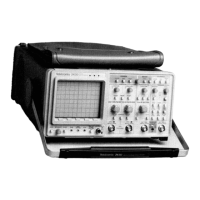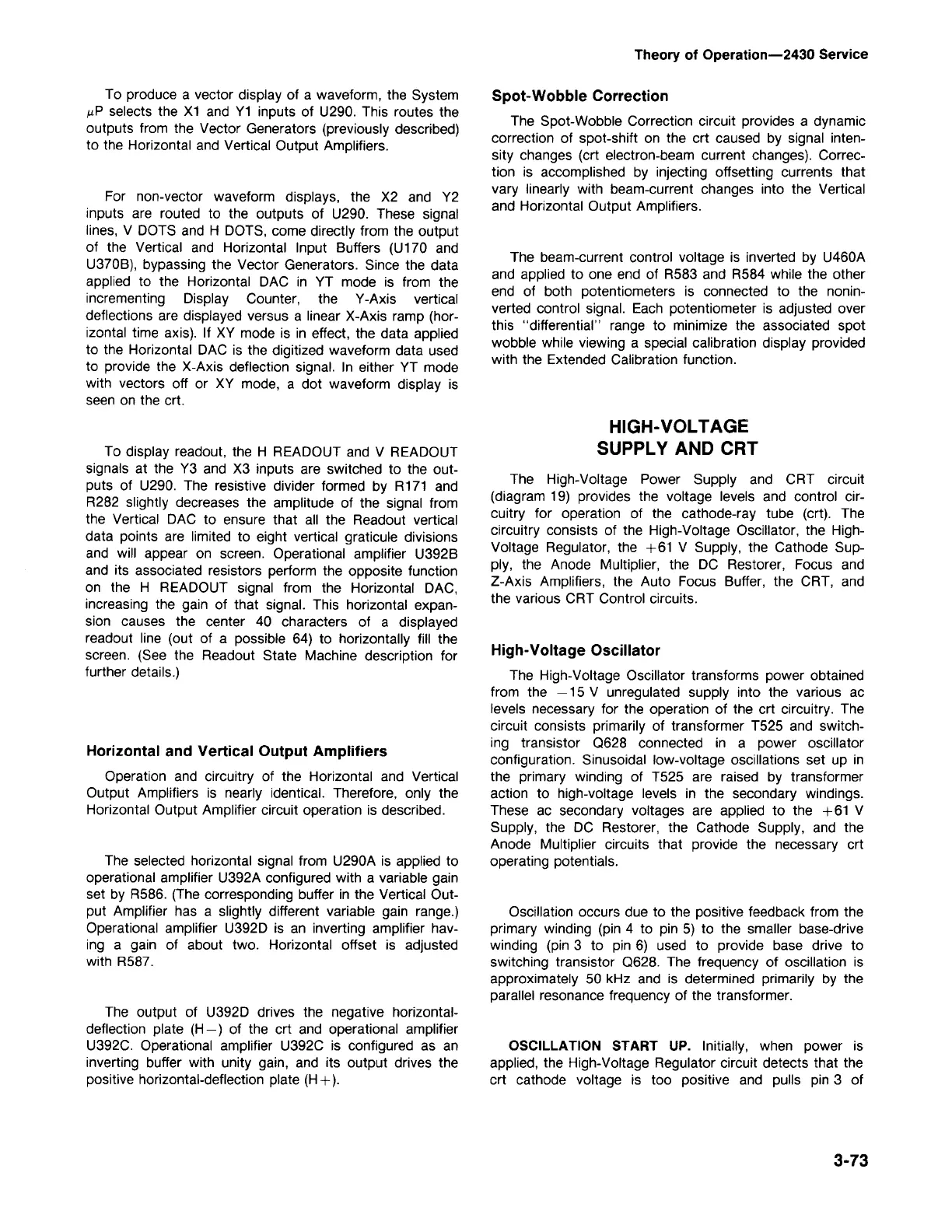3-73
OSCILLATION START UP.
Initially, when power is
applied, the High-Voltage Regulator circuit detects that the
crt cathode voltage is too positive and pulls pin 3 of
Oscillation occurs due to the positive feedback from the
primary winding (pin 4 to pin 5) to the smaller base-drive
winding (pin 3 to pin 6) used to provide base drive to
switching transistor
0628.
The frequency of oscillation is
approximately 50 kHz and is determined primarily by the
parallel resonance frequency of the transformer.
High-Voltage Oscillator
The High-Voltage Oscillator transforms power obtained
from the -15 V unregulated supply into the various ac
levels necessary for the operation of the crt circuitry. The
circuit consists primarily of transformer T525 and switch-
ing transistor
0628
connected in a power oscillator
configuration. Sinusoidal low-voltage oscillations set up in
the primary winding of T525 are raised by transformer
action to high-voltage levels in the secondary windings.
These ac secondary voltages are applied to the + 61 V
Supply, the DC Restorer, the Cathode Supply, and the
Anode Multiplier circuits that provide the necessary crt
operating potentials.
The High-Voltage Power Supply and CRT circuit
(diagram 19) provides the voltage levels and control cir-
cuitry for operation of the cathode-ray tube (crt). The
circuitry consists of the High-Voltage Oscillator, the High-
Voltage Regulator, the +61 V Supply, the Cathode Sup-
ply, the Anode Multiplier, the DC Restorer, Focus and
Z-Axis Amplifiers, the Auto Focus Buffer, the CRT, and
the various CRT Control circuits.
HIGH-VOLTAGE
SUPPLY AND CRT
The beam-current control voltage is inverted by U460A
and applied to one end of R583 and R584 while the other
end of both potentiometers is connected to the norun-
verted control signal. Each potentiometer is adjusted over
this "differential" range to minimize the associated spot
wobble while viewing a special calibration display provided
with the Extended Calibration function.
Spot-Wobble Correction
The Spot-Wobble Correction circuit provides a dynamic
correction of spot-shift on the crt caused by signal inten-
sity changes (crt electron-beam current changes). Correc-
tion is accomplished by injecting offsetting currents that
vary linearly with beam-current changes into the Vertical
and Horizontal Output Amplifiers.
Theory of Operation-2430 Service
The output of U392D drives the negative horizontal-
deflection plate (H-) of the crt and operational amplifier
U392C. Operational amplifier U392C is configured as an
inverting buffer with unity gain, and its output drives the
positive horizontal-deflection plate (H+ ).
The selected horizontal signal from U290A is applied to
operational amplifier U392A configured with a variable gain
set by R586. (The corresponding buffer in the Vertical Out-
put Amplifier has a slightly different variable gain range.)
Operational amplifier U392D is an inverting amplifier hav-
ing a gain of about two. Horizontal offset is adjusted
with R587.
Horizontal and Vertical Output Amplifiers
Operation and circuitry of the Horizontal and Vertical
Output Amplifiers is nearly identical. Therefore, only the
Horizontal Output Amplifier circuit operation is described.
To display readout, the H READOUT and V READOUT
signals at the Y3 and X3 inputs are switched to the out-
puts of U290. The resistive divider formed by R171 and
R282 slightly decreases the amplitude of the signal from
the Vertical DAC to ensure that all the Readout vertical
data points are limited to eight vertical graticule divisions
and will appear on screen. Operational amplifier U392B
and its associated resistors perform the opposite function
on the H READOUT signal from the Horizontal DAC,
increasing the gain of that signal. This horizontal expan-
sion causes the center 40 characters of a displayed
readout line (out of a possible 64) to horizontally till the
screen. (See the Readout State Machine description for
further details.)
For non-vector waveform displays, the X2 and Y2
inputs are routed to the outputs of U290. These signal
lines, V DOTS and H DOTS, come directly from the output
of the Vertical and Horizontal Input Buffers (U170 and
U370B), bypassing the Vector Generators. Since the data
applied to the Horizontal DAC in YT mode is from the
incrementing Display Counter, the Y-Axis vertical
deflections are displayed versus a linear X-Axis ramp (hor-
izonta~ time axis). If XY mode is in effect, the data applied
to the Horizontal DAC is the digitized waveform data used
to provide the X-Axis deflection signal. In either YT mode
with vectors off or XY mode, a dot waveform display is
seen on the crt.
To produce a vector display of a waveform, the System
J.LPselects the X1 and Y1 inputs of U290. This routes the
outputs from the Vector Generators (previously described)
to the Horizontal and Vertical Output Amplifiers.

